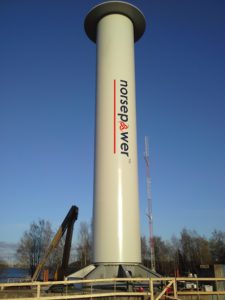INNOVATING THE FF8500
As competition always remains a challenge, the development of a new era ship design delivers the sustainability Switijnk Shipping is looking for, for the family, to anticipate on future demand and to remain competitive and to prolong its unique market position.
Objectives
- Development of the FF8500 Flettner Freighter concept, including installation of Flettner rotors and hull optimization and integration.
- Various real life tests in cooperation with industry partners, public bodies and knowledge institutes.
- Dissemination of test results of in-company applications of on board Flettner rotors concerning technical and business operation performances.
- Funding by means of a sustainable shareholder format and social entrepreneurship by modernization of the marine CV in a feasible business case.
- Maintaining and expansion of employment possibilities, knowledge and innovation in the small and medium sized shipping industry.
- Fostering the cooperation and networking to increasing the capacity for innovation of small and medium sized ship operators in the North of the Netherlands and beyond.
Energy concept
The design of the Flettner Freighter combines the operational criteria of Switijnk Shipping with a hybrid concept of an engine with auxiliary wind propulsion by Flettner rotors. The rotors save engine power and consequently reduce both expenses on fuel and carbon emissions. The energy concept therefore includes:
- Optimization of Flettner rotor configuration with the (long) hull design and overall vessel arrangement
- A Ship engine enabling optimal use of the forward thrust by Flettner rotors. This involves the need for an engine which is capable to deliver no excess thrust during favorable conditions.
Magnus Effect
 Two Flettner rotors will be placed on the weather deck. The exact location is to be determined based on further planning. The Flettner rotor is a cylinder which spins rapidly, generating the so-called Magnus effect.
Two Flettner rotors will be placed on the weather deck. The exact location is to be determined based on further planning. The Flettner rotor is a cylinder which spins rapidly, generating the so-called Magnus effect.
 The Magnus effect is the commonly observed effect in which a spinning ball (or cylinder) curves away from its principal flight path. The effect is used in a special type of ship stabilizers consisting of a rotating cylinder mounted beneath the waterline and emerging laterally. By controlling the direction and speed of rotation, strong lift or downforce can be generated.
The Magnus effect is the commonly observed effect in which a spinning ball (or cylinder) curves away from its principal flight path. The effect is used in a special type of ship stabilizers consisting of a rotating cylinder mounted beneath the waterline and emerging laterally. By controlling the direction and speed of rotation, strong lift or downforce can be generated.
The Flettner rotor design has been brought to market by Norsepower and is an innovative, alternative mean of thrust with the ability to hybridize maritime vessels. Life testing and use is tested on the M/V Estraden, a conventional roro vessel (9700 DWT).
Investment framework
The FF8500 will have an open collaboration approach, funds will be necessary to acquire for those projects which benefit public interests of shared innovation challenges, regional and sectoral development and the development of employment and education opportunities, to bridge the financial gap associated with the development of the first prototype.
Switijnk Shipping seeks for both private and public funding (loans, guarantees, equity, grants, venture capital) together with its partners C-Job Naval Architects and Norsepower. The partnership proceeded by initial investments in technology.
Ownership of the prototype vessel and its installations will be embedded in one or more legal entities, of which the structuring is part of the development process. Contact us if your are interested in investing or our Action Plan.